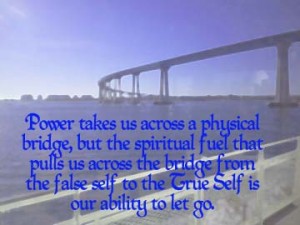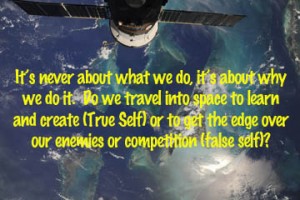By Cathy Eck
The Bridge
To get from one side of the river to the other, we need a bridge. Likewise, to get from one side of perception to the other side, we need a bridge. In any aspect of our lives, we can see the true world in the distance — no rules, no problems, no disease, creativity, joy, and freedom. Then we have our current reality that was created by our beliefs. When we get honest about where we are and where we know we belong, a bridge of pure thought appears.
Most people believe that crossing a bridge requires thinking of the destination or creating a plan. They visualize, affirm, and effort hoping to drag their asses across the bridge. They fight their current reality, created by their long-standing beliefs. Letting go of our beliefs seems counterintuitive because we think we have to create a thought bridge when we only have to reveal the bridge that already exists.
People step on bridges all the time. Someone gets a great idea for the design of a new house. They step on the bridge. Then they look at their bank account. They think about all the stuff they’d have to move. They realize it will be difficult to find the beautiful piece of land that they saw in their vision. So they step back down off the bridge and tell themselves to be happy with what they’ve got.
Normal thinking causes us to either turn away from true desires or to will them into submission with great effort. If we want to get across the bridge effortlessly, we must learn the art of letting go.
Don’t Look Back
A great story about crossing the bridge to our True Self is Lot’s Wife leaving Sodom and Gomorrah. She’s told by God to not look back. This is good advice if you understand it. She’s supposedly leaving her sin behind. We usually associate sin with bad deeds; but in the ancient world sin meant wrong thinking or missing the mark. Sinful or wrongful thinking causes you to miss your target destination.
Let’s return to our dream home example. The dreamer sees the image of the home vividly in mind. If it’s a True Self vision, it will feel great. But they won’t be thinking about looking good or throwing wild parties to impress their friends. They won’t feel excited; the vision will feel peaceful and right.
They step on the bridge to their new home. Crossing the bridge isn’t about doing; the bridge is made of pure thought. As they step on the bridge, thoughts arise from their false self that tempt them to look back or run back. When those thoughts arise, they should feel very bad. The emotions are telling them that their thoughts (or sin) are keeping them from crossing the bridge. So they must let them go.
Our false self doesn’t want us letting go. It tries to hold us back. So it projects our beliefs on to others to confuse us and cause us to hold on.
So friends tell our dreamer that their home idea is too expensive. The dreamer reads a special report on why people should never build a home exactly like the one they envisioned. They think, “Oh my God, that is a sign,” and start to look back. Fortunately they remember the art of letting go. The next day the special report is exposed as fraudulent. Their children hate the idea. Do they turn back? Their mother says the dream is a waste of money. Do they turn back?
Trolls are appearing under their bridge and building a toll booth. Their false self is working overtime to pull them back. They get a physical disease. They lose their job. This is what a true desire does; it forces us to let go of our beliefs because you enter the kingdom of the True Self naked — meaning no beliefs.
A true desire can’t be fulfilled with a vision board or a shit load of affirmations. It requires a very sturdy pure thought bridge that is crossed by continuously letting go of the anchors (beliefs) that hold us in the false self’s illusory world.
This is why no one crosses the bridge to the True Self. It’s the loneliest bridge on earth. The minute we start that walk, the illusion within our own mind keeps trying to get us to look or turn back. If we do, we turn to stone, meaning that we can’t reach our destination. We stay stuck in the illusion.
The Game
A healthy way to stay on course is to see crossing the bridge as a game. First, most games are not a matter of life and death so it lightens our perception. Second, children love to play games. Many childhood games are metaphors for getting lost and then finding our way — think “Hide and Seek” or “Pin the Tail on the Donkey.” When we take crossing the bridge too seriously, it’s painful. When we make it a matter of life or death, it’s horrific.
The people who want us to stay in the illusion appear to be our dreaded evil enemies. In the ordinary human mind, difficult or angry people are seen as enemies or pains in the ass. We fight them and oppose them. We ignore them and manipulate them. And we stay stuck in the illusion with them eternally — that is hell. Remember good and evil are two sides of the same illusion.
If we see them as allies exposing our beliefs, we get across the bridge much faster. In fact, they’re exactly what we need for success in crossing the bridge because they show we exactly what needs letting go. They show us our sins, our beliefs. When we see them as our reflection and refuse to break the mirror by letting go of what we see, our seeming enemies actually push us right across the bridge to freedom.


